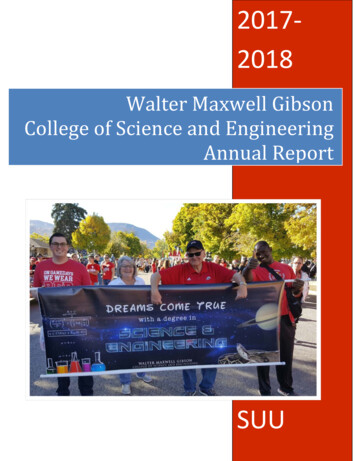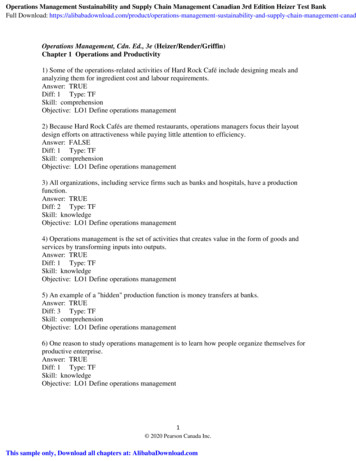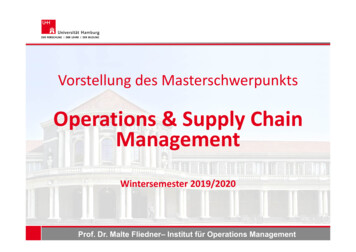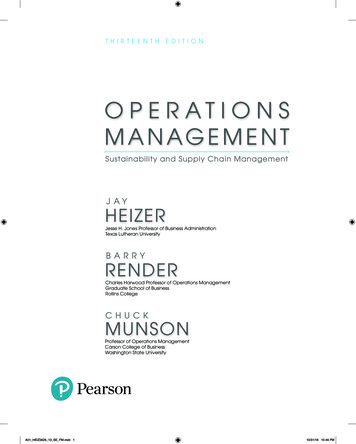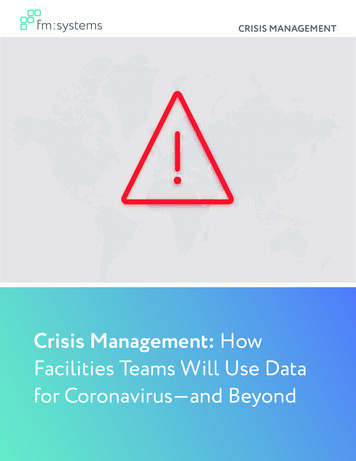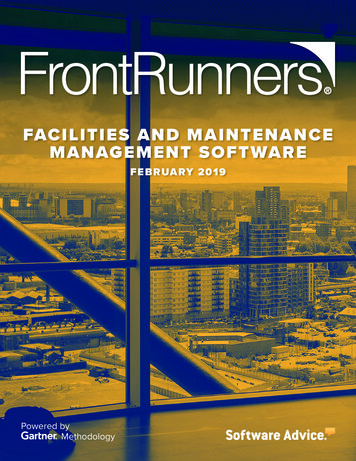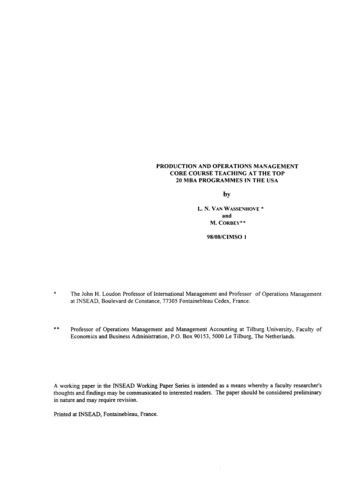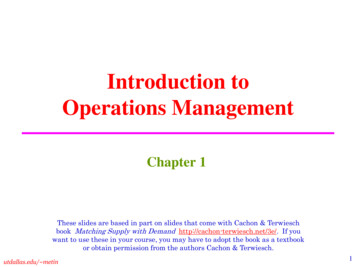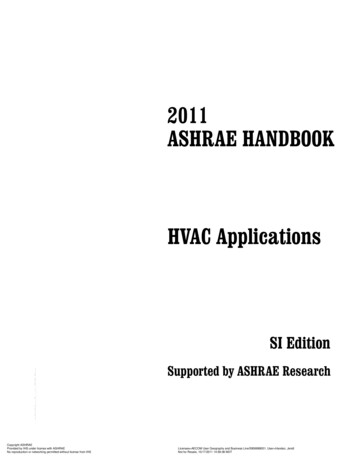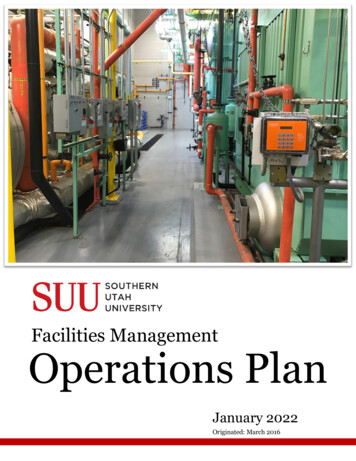
Transcription
Facilities ManagementOperations PlanJanuary 2022Originated: March 2016
Table of ContentsIntroduction . 3Mission and Organization . 3Mission, Vision, Core ValuesCore CompetenciesPersonnelFinancesWork OrdersKey Performance IndicatorsStrategic Focus . 7Sustainability and Energy ConservationEmergency PreparednessMulti-Year Capital Development PlanOperational Focus . 10Preventative and Corrective MaintenanceResource UtilizationCustomer ServiceStrategic Objectives . 11Goals, Objectives, Action ItemsOverview of Southern Utah University . 202
IntroductionFacilities Management functions as an integral part of Southern Utah University by providingquality buildings and outdoor spaces that enhance learning opportunities for current students, aswell as support the recruitment of new students. We are thoroughly engaged in the practice ofimplementing proactive solutions, which help us address problems before they become critical.An important component of this philosophy is to employ journeyman level trades, professionalpeople, and front-line staff, as well as students, who are encouraged to solve issues on site whilesupporting a variety of activities on campus. Our staff have the ability to make front linedecisions, allowing us to respond to the requests of individual customers quickly, while servingthe larger needs of the university effectively.Our inclusive organization is fervent about safety, employee well-being, regulatory compliance,record keeping, transparency, and cooperation with campus and state level entities. We host ahigh expectation of quality work within our organization to ensure an exceptional educationalenvironment, which is accessible, functional, and beautiful.Our mission statement underscores our commitment to student success. As we fulfill our vision,the department continues to expand its role as a critical component of SUU. Our commitment tostudents extends beyond simply caring for campus buildings; instead, we serve as a vital part ofrecruitment through quality facilities and retention through student mentoring and employment which improves graduation rates.Mission and OrganizationFacilities Management Mission StatementWe honor our commitment to student success by providing an exceptional learning environmentand opportunities which promote excellence at SUU.Facilities Management Vision StatementWe will improve the campus experience for all that join us at SUU by delivering exceptionalfacilities that are welcoming, accessible, and create a lasting impression. Facilities Managementstaff engage with the campus community in a professional and honorable manner, perform atthe pinnacle of their abilities, and mentor students for future success.Core ValuesAs an organization, Facilities Management understands the importance of coalescing around anucleus of common values which guide decisions within the department. By committing to thesevalues as an organization, we are more apt to make consistent, ethical, and forward-thinkingdecisions. Facilities Management has adopted the following four core values:Honor: honesty, integrity, ethical, loyalty, character, respect, work ethic, commitment,accountability, courtesy, cheerfulness, communication, stewardship, courage.Mentorship: student success, education, patience, commitment, employee/staff success,opportunity, inspiration.3
Culture: self-motivation, pride, ownership, innovation, creativity, initiative,assertiveness, expertise, inclusion, motivation, excellence, stewardship.Professionalism: conduct, communication, expertise, teamwork/collaboration, service-oriented,safety, goals/improvement, adaptability, quality, respect.Core CompetenciesFacilities Management at Southern Utah University recognizes four core competencies as central to theorganization. These are General Administration and Management; Maintenance and Operations;Energy and Utility Systems; and Planning, Design, and Construction. These competencies representthe broad range of responsibilities required to manage campus assets and resources effectively. Eachcompetency ties back to the departmental mission and vision in that they are components of promotingstudent success, managing safety and risk, making campus accessible, and realizing our department’svision and ability to provide exceptional learning environments and opportunities. Additionally, each corecompetency is supported by the department’s key performance indicators.Key Performance IndicatorsTracking organizational performance is paramount to ensuring the department is allocatingresources effectively and fulfilling our obligation to maintain and operate our facilities at orabove State standards. Additionally, these performance indicators help ensure that FacilitiesManagement is actively supporting the mission and strategic goals of the greater institution.1. Preventive Maintenance Audit Score as compared to State averages: The stateof Utah requires regular facility audits which substantiate the effectiveness of allaspects of facility management including administrative, custodial care, groundsand gardens upkeep, mechanical and electrical systems care, life safety, and thepreservation of building envelopes. State statute requires all state agencies tomaintain an average audit score of 90% or better over a rolling three-year period.Scores for SUU have been consistently over 90% for many years. The audit scoresare reflective of the effectiveness of the department and the appropriateness of theapplication of resources. Furthermore, these scores can be indicators of correctstaffing levels, and if the departmental focus is being directed too far away frommaintenance responsibilities and toward remodeling work aimed at meetingoperational needs. In 2020, the State of Utah transitioned to self-evaluations byeach higher ed institution. The reported score reflects this transition.YearSUU Score201891.7201994.7202095.1202194.82. Capital Development Initiatives to meet the growth needs of the University:Over the last ten years, SUU has continuously engaged in the acquisition, design, andconstruction of capital facilities, which directly supports Objective 2.3.5 as outlinedin the University’s Strategic Plan. These projects have been in the form of new oracquired buildings which house classrooms, offices, administrative, and support4
space; student housing and living/learning environments; athletic facilities; alsoparking and exterior greenspace such as intramural resources have been added.Facilities Management further supports the Strategic Plan by securing funding forand executing more than 3 million of capital improvement projects each year thatfurther enhance the education and professional opportunities of students, faculty, andstaff on campus. Facilities Management regularly secures professional consultingservices for engineering studies and master planning on behalf of SUU, which informall strategic growth decisions.PersonnelThe number of full-time staff in Facilities Management fluctuates as new buildings are added toour inventory or as departmental assignments vary. Facilities staff contribute specialized skillsand assist in the innovation and optimal performance of the department. Together, staffmembers work as a unified and cooperative force to accomplish goals and projects on campus.Additionally, they value the ability to collaborate, to exemplify best practices, and producequality craftsmanship. Each year, with the retirement of well-tenured individuals, thedepartment is at risk of losing extensive and valuable campus knowledge. FacilitiesManagement staff work to mentor each other to preserve institutional knowledge and createdepth in the organization. This mentoring model is extended to student employees, providingthem with valuable work experience and skills that enhance the student’s collegiate experienceat Southern Utah University, and their preparedness for future careers. Many FacilitiesManagement staff hold higher education degrees, which give them a unique understanding of5
the needs of students across campus.Facilities Management employs about 340 people, of which approximately 280 are students (varies byseason). Each of these student positions plays a vital role in the daily functions and success of theuniversity. These positions are meaningful, and assist in skill development, improved communication,and provide direct responsibility. Each student position within Facilities Management serves animportant purpose in the mission and objectives of the department, in addition to those of the institution.FinancesAs a part of Southern Utah University, Facilities Management receives an average budget of 12.4M annually in state appropriated funds. Of this 12.4M, approximately 7.2M is allocatedfor payroll expenses and 5.2M for operating expenses. Also, each fiscal year, the departmentreceives capital improvement funds from the state, typically totaling over 3M. These funds aredesignated to major projects such as the replacement of campus infrastructure and capitalequipment. This allotment is based upon the State of Utah Capital Improvement guidelines,which equals 1.3% of the replacement value of existing campus buildings. The State allocatescapital improvement dollars before any capital development projects can be approved eachyear.6
Outside of appropriated and capital improvement funding, Facilities Management generatesrevenues from divisions within the department such as Sign Shop Operations and other smallersources. These revenues are designed to offset direct costs such as operations, supplies, andmaterials. Some of these dollars are generated from rent reimbursements and facility use fees.Work OrdersFacilities Management utilizes an active work order system on campus, which is currently runthrough the software Sprocket by Dematic. In FY21, 3,527 work orders were completed. Thework order system is used to communicate maintenance needs from the campus to FacilitiesManagement and assists the university in timelier and more efficient project completion, inaddition to facilitating more in-depth record keeping.The use of this software provides improved connections and communication among faculty,staff, and students in a continued effort to keep campus safe, accessible, and beautiful. Theapplication of the work order system continues to evolve as needs change and improvements aremade.Strategic FocusInitiatives considered as Strategic Focus include projects where Facilities Management isinvolved, along with other entities. The Facilities department largely takes the lead, ensuringthese projects are moving forward.Capital ImprovementEach fiscal year, in collaboration with pertinent departments on campus, Facilities Managementdevelops a list of capital improvement needs which are submitted to DFCM for fundingconsideration. This list of projects is compiled with strong consideration for the strategicinitiatives of the University through consultation with the institution’s Strategic Plan andadministrators. Projects that make the final cut for submission are those which fully support the7
Strategic Plan and academic endeavors of SUU, along with, accessibility and life safety, andwhich promote student success by addressing campus infrastructure deficiencies. FacilitiesManagement is expanding this list into a 5-year capital improvement plan for guidingupcoming campus projects.Sustainability and Energy ConservationFacilities Management makes energy conservation and sustainability a priority. In 2007, SUUadministrators and Facilities Management coupled resources to establish a fund designated forenergy savings projects across campus. By working with an energy consultant, energyconservation measures were identified through an investment grade audit of university buildings.From this list of conservation measures, Facilities Management personnel implementednumerous projects with reduced energy consumption as the primary objective. These projectshad payback timelines from 0.5 - 12 years, with an average return on investment of 4.7 years. Asa result, the total kBTU’s consumed on campus has dropped from the FY07 baseline to FY21.During this same period, the gross square footage of campus continued to increase. Since 2007,energy savings have exceeded nearly 1,000,000.Although there had been a major campus energy audit completed in 2007, which resulted insignificant energy savings for the campus, Facilities Management continues to pursue energyrelated projects on an on-going basis. To confirm the effectiveness of these types of projects,Facilities Management recently collaborated with a third-party energy consultant. A secondaudit was carried out on 21 major campus buildings. In addition to evaluating previousconservation projects, several new innovative energy conservation strategies were explored. Theresults not only confirmed the energy conservation measures completed to date had beeneffective, but also identified additional potential projects. Unfortunately, most of these newopportunities have an extended return on investment, thus diminishing their true value tocampus.With SUU administration’s commitment to energy conservation, Facilities Management willcontinue to pursue energy-related projects that have financial viability and contribute toenhancing occupant comfort. By working with consultants like Wattsmart and the BrendelGroup, Facilities Management is able to master plan the future of these initiatives. Anticipatedupcoming projects will include upgrades to utility sub-metering, low-consumption restroomappliances, continued conversions to LED lighting products, building re-commissioning,ongoing preventative maintenance, analysis of mechanical systems design, piping insulationupgrades, building automation, and further development of a water management plan. Asthese projects are pursued, off-campus funds will also be sought by working with utilitysuppliers to secure grants and incentives.All new construction at SUU meets the state of Utah’s high-performance building standards,which exceed national energy code standards by more than 20%. Over the life of a givenbuilding, the energy savings and reduced environmental footprint are substantial.8
Emergency PreparednessFacilities Management is working with other campus entities to increase campus emergencyresponse capabilities. Recognizing that unified organization and communication are ofparamount importance, SUU has adopted the federal emergency command structure as definedby FEMA. This model aligns with other federal, state, and local government response plans andobjectives.Serving as the Emergency Coordination Center (ECC) for campus incidents, as outlined in theFEMA Command Structure, Facilities Management plays a key role in ensuring proper supportis provided to first responders and that SUU administrators are kept informed throughout anevent.9
Multi-Year Capital Development PlanSouthern Utah University is committed to an upward growth pattern for the foreseeable future.Facilities Management supports this plan by working closely with top campus administrators inevolving an outlook for capital development projects. These projects are identified in response tothe strategic needs of the campus, with consideration for building age, building functionality,academic priorities, and administrative objectives. Capital Development projects are pursued asfunding and approval from state authorities become available. Facilities Management assists withthe creation and submittal of Capital Development Requests each year, and management of theprojects once they are funded.Operational FocusInitiatives identified as Operational Focus include objectives that are part of the daily operationsof Facilities Management. These areas of concentration are key to Facilities’ support of themission of the university. By improving these areas, Facilities Management’s customer base,including students, is directly affected. The Facilities Management front line staff are essentialto the success of the items defined as operational focus points. Without the support andcommitment of the entire department, Facilities would falter in its ability to interact with thecampus, respond to emergent issues, and preserve departmental resources.Preventative and Corrective MaintenanceFacilities Management at SUU is responsible for over 550 million worth of state assets. Thedepartment’s responsibility to the taxpayer is rooted in the preservation of these assets, ensuringthey are optimized for the maximum lifespan possible. Preventative maintenance is a key aspectof this process, a practice that is part of our proactive approach to solving issues in their infancy.Facilities Management uses commercial software to organize and schedule routine preventativemaintenance on all pertinent campus elements. These include areas such as roofing, buildingshells, custodial care, building mechanical systems, grounds equipment, and departmentvehicles.The execution of a successful preventative maintenance program, such as that used at SUU,results in many benefits. Some of those benefits include improved systems reliability, reducedimpact to campus end-user groups, enhanced safety, energy conservation, extended product andequipment life, extension of building life, and improved student satisfaction as a result of higherquality learning environments.At times, measures are necessary to repair or replace campus elements that have failedunexpectedly. Defined as corrective maintenance, this portion of the Facilities Managementworkload is minimized as a result of preventative measures and planned system replacement thathelp ensure a reduction in downtime and a virtually seamless user experience.The success of this approach to maintenance, preventative and corrective, is reflected in state10
audit reports and self-evaluations, which consistently score SUU facilities in the mid-90thpercentile for overall building condition and administrative processes.Resources UtilizationAmong the various resources utilized, Facilities Management pursues the best value in theprojects and initiatives conducted on campus. The department is forward-looking in allaspects of purchasing and utilizing resources that benefit campus in both the present and thefuture. In the search for material resources, the department follows Southern UtahUniversity’s purchasing policies and procedures, taking care to seek bids and make educateddecisions based on best value.The department works to reduce the number of physical resources utilized while maintainingquality in all projects. Staff also strive to reuse and recycle resources in addition to being mindfulof energy and water conservation efforts. In addition to a long list of completed energyconservation projects, Facilities Management has photovoltaic solar panels in place at both theFacilities Management Administration building and the Shops, and makes conscious efforts toimprove the awareness of energy savings on campus. From a financial perspective, FacilitiesManagement establishes budgets and plans for the financial resources they are provided and theyseek to utilize those resources responsibly.Customer ServiceFacilities Management strives for exceptional customer service. As a team, the department workswith campus administration, faculty, staff, and students to provide positive experiences andenvironments where everyone can safely learn and develop. In addition to on-campusrelationships, Facilities Management creates positive and lasting relationships with outsidevendors and community members, fostering a cooperative culture for maintaining an outstandingcampus.These customer service traits come from consistently nurtured relationships and a collaborativeteam that seeks to communicate with one another in a courteous and respectful manner. Tosupport a high level of service, the department is responsive to work requests and makes everyeffort to maintain effective communication with campus contacts.Strategic ObjectivesFacilities Management works toward achieving strategic objectives on an ongoing basis. Bymeeting regularly, the department’s leadership team can foster a continuous solution-orientedconversation that leads to the implementation of an evolving list of strategic objectives. Thisteam evaluates issues to determine what opportunities can be gained, as well as identifying thepotential threats and unintended consequences of a decision or outcome. The primary strategyrevolves around a departmental commitment to finding the best solution for the University - notthe solution that may be self-serving to the department or individual division. By holding firm tothis approach, Facilities Management collectively benefits from decisions and solutions that are11
designed to serve the most strategic needs of the department and its service to the institution.These decisions invariably lead to the most cost-effective and long-term outcomes.The following goals are broad by design and allow the organization to respond to the needsof the greater institution without having to redefine departmental goals every time theclimate on campus changes. This provides improved continuity for Facilities staff.The objectives listed under each goal reflect, without priority, elements of the solutions that willmove the department towards the respective goal. Because the nature of managing facilities islargely reactive to current conditions, having the ability to adjust the objective priorities allowsfor a more flexible and responsive organization. At any given time, several objectives are beingaddressed at once.The action items listed in the following tables are expanded or collapsed as the scope of therelated objective is adjusted, which may occur as unforeseen elements, such as workload orbudget. Additionally, these action items serve as indicators of forward movement. As strategicconversations continue in Facilities Management, the action items will be the focus of currentplanning and implementation.Goal 1: Focus on improving operational processes within FacilitiesManagement that will enhance the efficiency and effectiveness of thedepartment.ObjectiveAction ItemsTimeline(Listed withoutpriority)1.1 Develop areplacement planfor capitalequipmentResourcesRequiredIndicator/s ofAchievementDesiredOutcomeStatus(all staff are existingunless indicated)· Inventory itemsthat fit definedcriteria to developthe scope· Assess expectedlifespan ofequipment basedon ASHRAE data· Prioritizeitems based onequipmentperformance andservice history0-18months2 FT 2 SE*12Effectivebudgetplanning basedon calculatedreplacementschedulesA plan thatprovides astrategicapproach toreplacingcapitalequipmentrelated tobuildingoperations.See Archive1/22: Work isongoing tointegrateequipmentdata into thework ordersystem.
1.2 Improve orMaintainCooperativeRelationshipswith Local City,County, andState Agencies1.3 EnhanceEmergency ResponsePlans1.4 Management offuture CapitalImprovement andCapitalDevelopment funds· Hold planningsessions forprojects thatoverlap injurisdiction· Share SUUFacilitiesManagement plansfor capitalimprovement orreplacement ofparking lots,curbing, sidewalks,utility-relateditems, and newconstructionprojectsImprove FEMAplanning for ECCoperations· Establish ECC· operation capabilityin FacilitiesManagementbuilding. Bolster on- campuscommunication· Communicateresources andneeds with localpublic agenciesCoordinate priorityprojects intomanageable segments0-60months:ongoing· Compare prioritizeddepartment needswith systemCapabilities.Improve theinterface of thework order systemwith campusoperationsMutual benefitand potentialsavings fromcooperativeprojectsbetween SUUand UDOT,Cedar CityCorp., IronCounty, ICSD.Quickerresponse onroad inquiries,permits, etc.0-12 months 30,00025 FT hoursImprovedresponse toemergencies25 SE hoursAlign the SUUemergencyresponse planwith nationalFEMA standards.Meetingsoccur on an adhoc basis.See Archives.1/22:Coordinationwith UDOT andCedar City isunderway toimprove stormwater drainagearoundcampus.Working onseveraleasements.A regularstrategic effortin cooperationwith SUUPolice Dept.See Archives.1/22:Tabletoptraining is inthe planningphase forFacilitiesManagementleadershipteam. Strategicconversationsoccurregularly.0-24 months3 FTProfessionaldevelopment: 5000Bolster staffing levelsin appropriate areasto ensure qualifiedstaff are availableEvaluate existing workorder system, assesssystem capabilitiesA decrease inpoints ability to gainefficienciesfrom likeprojectsAdditionalprojectmanagementstaff: TBDRespond to impendinglegislation/DFCM ruleswith appropriatestaffing levels.1.5 Pursue a workorder systemsolution that bettermeets theneeds of FacilitiesManagementAdministrativetime as needed60 months2 FT and etion ofmajor projectsImprovedredundancy ofprojectmanagersFavorablerating fromDFCM onprojectmanagementImprovedaccuracy andreportingInterface withBannerProvide front linestaff withan effective toolProvide effectivein- housemanagementof major projectson CampusDecrease overallcost of the workorder system andimprove workorder processingand reportingefficiencySee Archives1/22: Discussionsrelated to themanagement ofresourcesrequired tooversee capitalprojects. Projectcoordinationstaffing has beenincreased.See Archives1/22: Tabled
1.9 Balancestaffing levelsv. workload- Use benchmarkdata to determinelevels of staff tosquare footage- Utilize APPA data-Coordinatescheduling toproduce qualityoutcome-Proper balance ofMaintenance v.Operations/remodels-Evaluate # ofstudent staffassigned to0-12monthsAdministrative time asneededMinimal workoutside of adesignated shifteach FTE.1.10 Makeprocesses moreuser-friendly1.11 Timelycommunication withstaff and campus-Create an app orsimilar tool forservice callreporting-Provide bettermobile technologytools for our staff-Teach Call Centerto create workorders for nonemergency issues-Respond to allrequests for action-Create checklists-Use email forregular updates-Hire a student toconvey informationabout projects withthose who areaffected: face to face.Reduced comptime0-12monthsAdministrativetime as needed.Improvedfeedback fromcustomersFront line stafftraining and input.Improvedbalance ofmaintenanceand operationselementsImprovedscore onDFCMfacilities conditionassessmentmonthsAdministrativetime as neededFewer itemslost in process.Improvedfeedbackfromcustomers141/22: Positionplanningunderway forwhen ACBcomes on line.Additionalstaffing forcustodial andrepairs divisionsis in place.BetterSee Archivebetweencampus andour staff.1/22:communicationReduced waittime on failurepoints oncampus0-12See ArchiveReducedresponsetime towork orderor otherrequestsfromcampus.Ongoingeffort toimproveprocessesand makeinformationmoreaccessible forstaffmembers.See Archive1/22:Improveddistribution ofmeetinginformation isongoing.
1.13 Balancetime andworkloadbetweenmaintenanceand operations/remodelprojects-Use data to showthe need formaintenance0-12months,ongoing-Ensure projectsare true to theneeds of E&GfundingLeadershipteamcommitment toprioritizemaintenancework-Schedulemaintenance asprojects arescheduled1.14 Evaluatetheopportunitieswhich may bepresent withadding asecond shift toFacilitiesManagementoperations-Explore whichtrades would bemost valuable on asecond shift-Define the optimalwork times for asecond shift-Identify thebenefits of havingstaff on campuslate in the day0-12months.1.15 Provideemployees withvisiblecredentials foruse whileworking oncampus-Define whencredential must beworn-Design credentialand requiredinformation-Show benefits ofusing credentials-Establish whichother schools areusing them and thebenefits of it6-18months1.16 Respondto growthdemands byadding squarefootage to ibility studycompleted24 months1.17 Developmaster plan forFacilities Yard-Map out existingresourcesLeadershipteam timeCreate a meansto offer theopportunity tostaff-Maintenanceitems not shownas delinquent inthe work edsupport for afterhours events-Quickerresponse toemergencies-Improvescheduleofferings forstaffLeadershipteam timeMoney toproducecredentials-Secure fundingfor tenantimprovementthrough capitalimprovementfunds1 FTE 1 SE-Configure spaceto be moreefficient* SE – Student Employee, FT – Full Time15-Enhancedsupport ofcampus eventsand activities-Improvedidentification dfeasibility study-Fundingapproval fromDFCM12 months-Evolution ofFacilitiesManagementwith campusgrowth-Improvedidentification ofstaff-Improvedcommunicationwith buildingoccupants 727,000Better overallcondition offacilities andeducationalresources forstudentsImprovedorganization andappearanceSee Archive1/22:Will continueto look foropportunities.See Archive1/21: Custodianhired withspecificresponsibility ofnightmanagement.1/22: Custodialstaffing andeventtechnicianadded forsecond shiftcoverage-Improvedcommunicationwith buildingoccupantsAdditionalspacecompleted by2022.ImprovedaestheticsCost savingsfrom storagesolutionsSee Archive1/22:FacilitiesManagement masterplan isbeingupdated toinclude thisand otherprojectsSee Archive1/22: Indevelopment.Phase I itemsare underway.
Goal 2: Pursue elements that en
Facilities Management utilizes an active work order system on campus, which is currently run through the software Sprocket by Dematic. In FY21, 3,527 work orders were completed. The work order system is used to co
